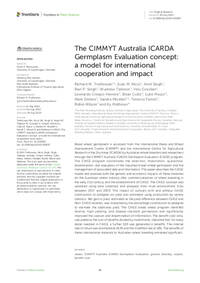The CIMMYT Australia ICARDA Germplasm Evaluation concept: a model for international cooperation and impact

Authors:
Bread wheat germplasm is accessed from the International Maize and Wheat Improvement Centre (CIMMYT) and the International Centre for Agricultural Research in the Dry Areas (ICARDA) by Australian wheat breeders and researchers through the CIMMYT Australia ICARDA Germplasm Evaluation (CAIGE) program. The CAIGE program coordinates the selection, importation, quarantine, dissemination, and evaluation of the imported bread wheat germplasm and the management of associated data and information. This paper describes the CAIGE model and assesses both the genetic and economic impacts of these materials on the Australian wheat industry after commercialisation of wheat breeding in the early 21st century and the establishment of CAIGE. The CAIGE concept was validated using data collected and analysed from multi-environment trials between 2017 and 2020. The impact of cultivars with and without CAIGE contribution to pedigree on yield was estimated using production-by-variety statistics. Net gain in yield, estimated as the yield difference between CAIGE and Non-CAIGE varieties, was multiplied by the percentage contribution to pedigree to estimate the additional yield. The CAIGE bread wheat program identified diverse, high-yielding, and disease-resistant germplasm and significantly improved the capture and dissemination of information. The benefit-cost ratio, calculated as the sum of benefits divided by investments, indicated that, for every dollar invested in CAIGE, a further $20 was generated in benefits. The internal rate of return was estimated at 163% and the modified rate at 18%. The benefits of these international materials to Australian wheat breeding remained significant.
